Energy Efficiency Analysis: HVAC System Redesign in David Weekly Homes
VerifiedAdded on 2023/06/11
|38
|11016
|160
Report
AI Summary
This report details an analysis conducted by Building Science Corporation (BSC) in collaboration with David Weekly Homes to improve the ventilation, heating, and cooling systems in residential buildings. The primary goal is to develop a cost-effective design that enhances ventilation and air cooling, aiming for a 50% energy saving target. The study involves redesigning the HVAC system, moving it from conventional attic spaces to coffers, and utilizing ANSYS Fluent software for simulation and analysis. The report includes a literature review of air conditioning, heating, and ventilation systems, focusing on heat exchange, cooling mechanisms, and condensate recovery. The analysis covers temperature and pressure contours, velocity streamlines, and radiative heat flux within the room, providing insights into optimizing HVAC systems for better energy performance and reduced energy ratings in homes. The document is shared by a student on Desklib, a platform offering a range of study tools and resources.
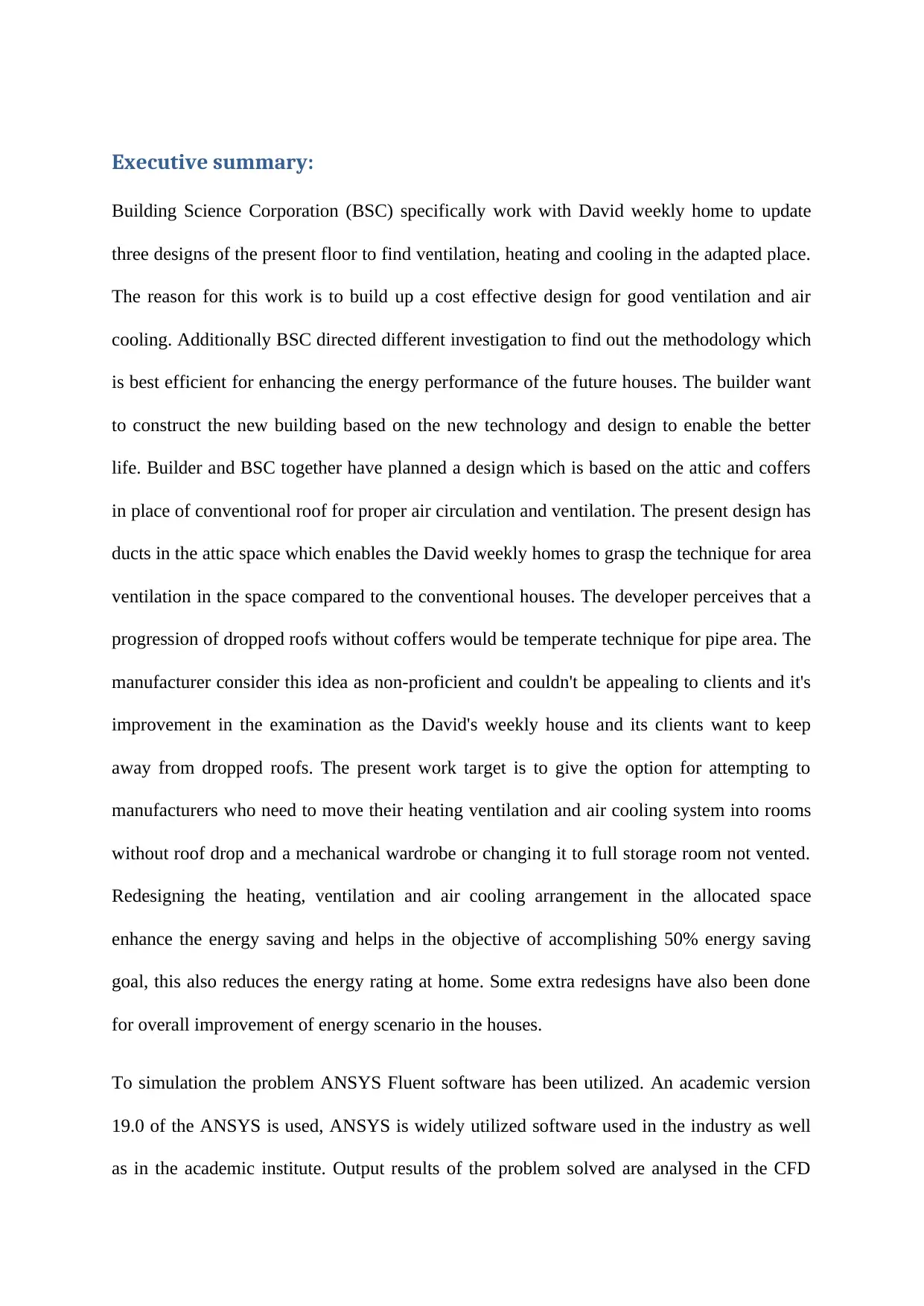
Executive summary:
Building Science Corporation (BSC) specifically work with David weekly home to update
three designs of the present floor to find ventilation, heating and cooling in the adapted place.
The reason for this work is to build up a cost effective design for good ventilation and air
cooling. Additionally BSC directed different investigation to find out the methodology which
is best efficient for enhancing the energy performance of the future houses. The builder want
to construct the new building based on the new technology and design to enable the better
life. Builder and BSC together have planned a design which is based on the attic and coffers
in place of conventional roof for proper air circulation and ventilation. The present design has
ducts in the attic space which enables the David weekly homes to grasp the technique for area
ventilation in the space compared to the conventional houses. The developer perceives that a
progression of dropped roofs without coffers would be temperate technique for pipe area. The
manufacturer consider this idea as non-proficient and couldn't be appealing to clients and it's
improvement in the examination as the David's weekly house and its clients want to keep
away from dropped roofs. The present work target is to give the option for attempting to
manufacturers who need to move their heating ventilation and air cooling system into rooms
without roof drop and a mechanical wardrobe or changing it to full storage room not vented.
Redesigning the heating, ventilation and air cooling arrangement in the allocated space
enhance the energy saving and helps in the objective of accomplishing 50% energy saving
goal, this also reduces the energy rating at home. Some extra redesigns have also been done
for overall improvement of energy scenario in the houses.
To simulation the problem ANSYS Fluent software has been utilized. An academic version
19.0 of the ANSYS is used, ANSYS is widely utilized software used in the industry as well
as in the academic institute. Output results of the problem solved are analysed in the CFD
Building Science Corporation (BSC) specifically work with David weekly home to update
three designs of the present floor to find ventilation, heating and cooling in the adapted place.
The reason for this work is to build up a cost effective design for good ventilation and air
cooling. Additionally BSC directed different investigation to find out the methodology which
is best efficient for enhancing the energy performance of the future houses. The builder want
to construct the new building based on the new technology and design to enable the better
life. Builder and BSC together have planned a design which is based on the attic and coffers
in place of conventional roof for proper air circulation and ventilation. The present design has
ducts in the attic space which enables the David weekly homes to grasp the technique for area
ventilation in the space compared to the conventional houses. The developer perceives that a
progression of dropped roofs without coffers would be temperate technique for pipe area. The
manufacturer consider this idea as non-proficient and couldn't be appealing to clients and it's
improvement in the examination as the David's weekly house and its clients want to keep
away from dropped roofs. The present work target is to give the option for attempting to
manufacturers who need to move their heating ventilation and air cooling system into rooms
without roof drop and a mechanical wardrobe or changing it to full storage room not vented.
Redesigning the heating, ventilation and air cooling arrangement in the allocated space
enhance the energy saving and helps in the objective of accomplishing 50% energy saving
goal, this also reduces the energy rating at home. Some extra redesigns have also been done
for overall improvement of energy scenario in the houses.
To simulation the problem ANSYS Fluent software has been utilized. An academic version
19.0 of the ANSYS is used, ANSYS is widely utilized software used in the industry as well
as in the academic institute. Output results of the problem solved are analysed in the CFD
Paraphrase This Document
Need a fresh take? Get an instant paraphrase of this document with our AI Paraphraser
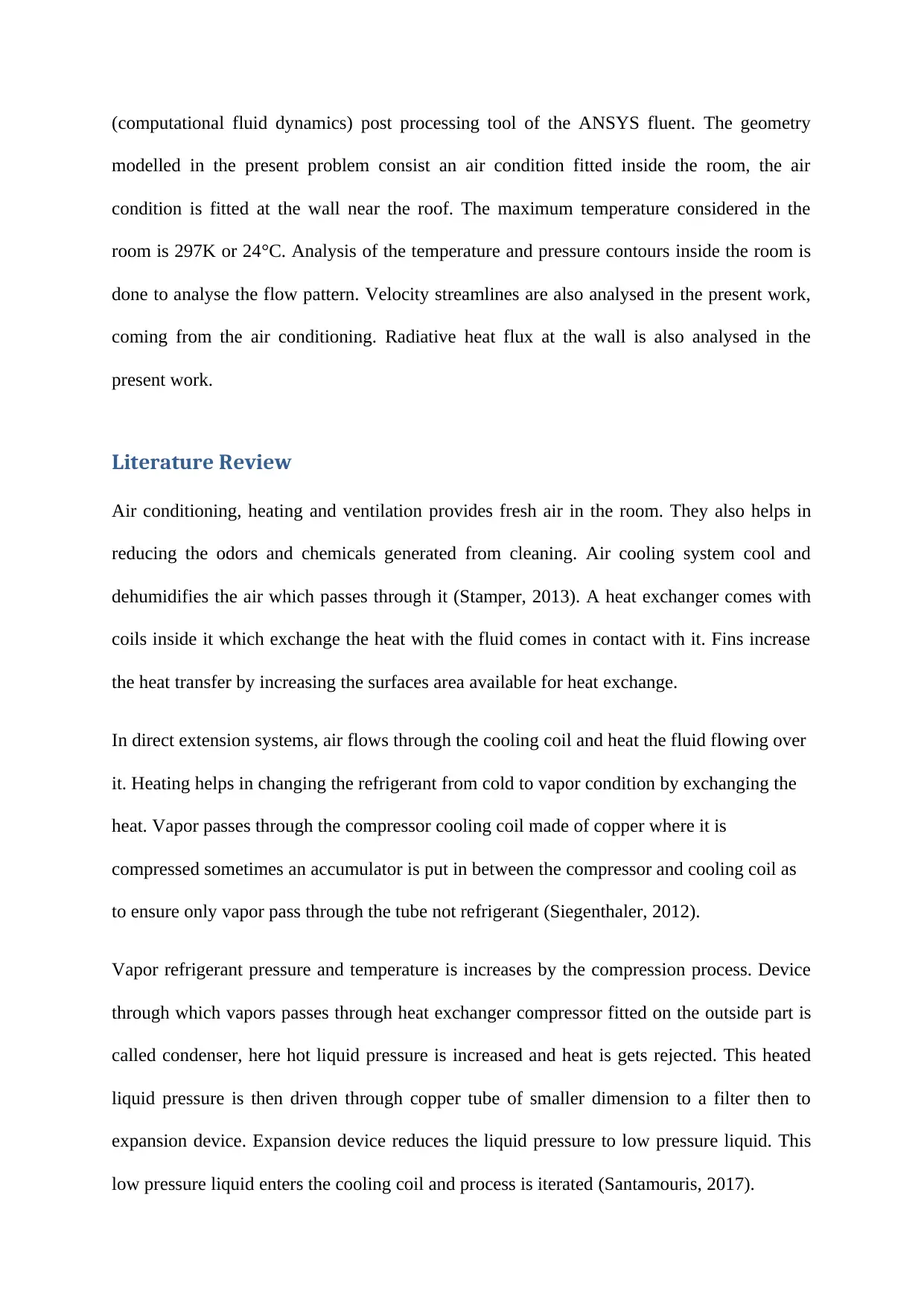
(computational fluid dynamics) post processing tool of the ANSYS fluent. The geometry
modelled in the present problem consist an air condition fitted inside the room, the air
condition is fitted at the wall near the roof. The maximum temperature considered in the
room is 297K or 24°C. Analysis of the temperature and pressure contours inside the room is
done to analyse the flow pattern. Velocity streamlines are also analysed in the present work,
coming from the air conditioning. Radiative heat flux at the wall is also analysed in the
present work.
Literature Review
Air conditioning, heating and ventilation provides fresh air in the room. They also helps in
reducing the odors and chemicals generated from cleaning. Air cooling system cool and
dehumidifies the air which passes through it (Stamper, 2013). A heat exchanger comes with
coils inside it which exchange the heat with the fluid comes in contact with it. Fins increase
the heat transfer by increasing the surfaces area available for heat exchange.
In direct extension systems, air flows through the cooling coil and heat the fluid flowing over
it. Heating helps in changing the refrigerant from cold to vapor condition by exchanging the
heat. Vapor passes through the compressor cooling coil made of copper where it is
compressed sometimes an accumulator is put in between the compressor and cooling coil as
to ensure only vapor pass through the tube not refrigerant (Siegenthaler, 2012).
Vapor refrigerant pressure and temperature is increases by the compression process. Device
through which vapors passes through heat exchanger compressor fitted on the outside part is
called condenser, here hot liquid pressure is increased and heat is gets rejected. This heated
liquid pressure is then driven through copper tube of smaller dimension to a filter then to
expansion device. Expansion device reduces the liquid pressure to low pressure liquid. This
low pressure liquid enters the cooling coil and process is iterated (Santamouris, 2017).
modelled in the present problem consist an air condition fitted inside the room, the air
condition is fitted at the wall near the roof. The maximum temperature considered in the
room is 297K or 24°C. Analysis of the temperature and pressure contours inside the room is
done to analyse the flow pattern. Velocity streamlines are also analysed in the present work,
coming from the air conditioning. Radiative heat flux at the wall is also analysed in the
present work.
Literature Review
Air conditioning, heating and ventilation provides fresh air in the room. They also helps in
reducing the odors and chemicals generated from cleaning. Air cooling system cool and
dehumidifies the air which passes through it (Stamper, 2013). A heat exchanger comes with
coils inside it which exchange the heat with the fluid comes in contact with it. Fins increase
the heat transfer by increasing the surfaces area available for heat exchange.
In direct extension systems, air flows through the cooling coil and heat the fluid flowing over
it. Heating helps in changing the refrigerant from cold to vapor condition by exchanging the
heat. Vapor passes through the compressor cooling coil made of copper where it is
compressed sometimes an accumulator is put in between the compressor and cooling coil as
to ensure only vapor pass through the tube not refrigerant (Siegenthaler, 2012).
Vapor refrigerant pressure and temperature is increases by the compression process. Device
through which vapors passes through heat exchanger compressor fitted on the outside part is
called condenser, here hot liquid pressure is increased and heat is gets rejected. This heated
liquid pressure is then driven through copper tube of smaller dimension to a filter then to
expansion device. Expansion device reduces the liquid pressure to low pressure liquid. This
low pressure liquid enters the cooling coil and process is iterated (Santamouris, 2017).
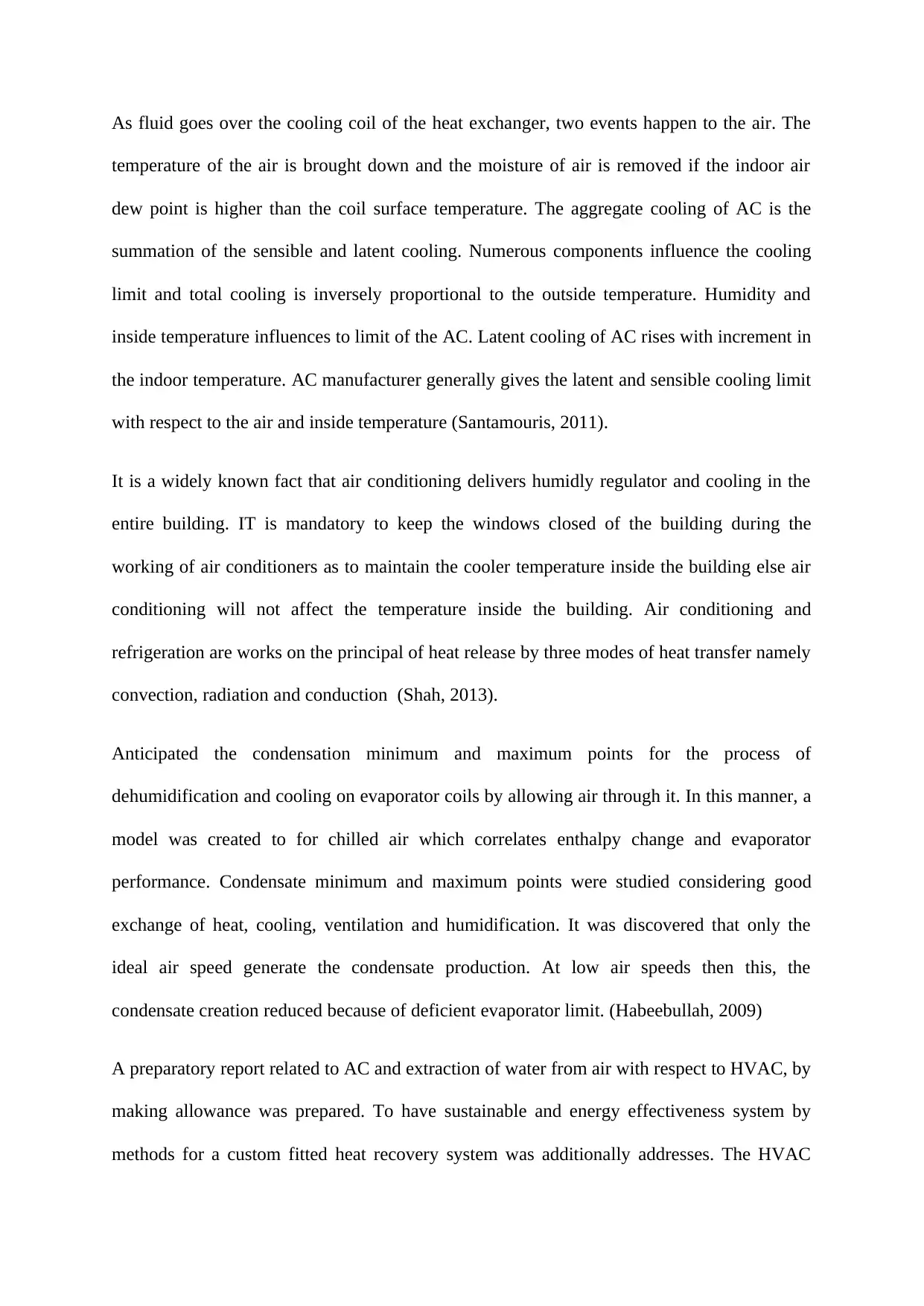
As fluid goes over the cooling coil of the heat exchanger, two events happen to the air. The
temperature of the air is brought down and the moisture of air is removed if the indoor air
dew point is higher than the coil surface temperature. The aggregate cooling of AC is the
summation of the sensible and latent cooling. Numerous components influence the cooling
limit and total cooling is inversely proportional to the outside temperature. Humidity and
inside temperature influences to limit of the AC. Latent cooling of AC rises with increment in
the indoor temperature. AC manufacturer generally gives the latent and sensible cooling limit
with respect to the air and inside temperature (Santamouris, 2011).
It is a widely known fact that air conditioning delivers humidly regulator and cooling in the
entire building. IT is mandatory to keep the windows closed of the building during the
working of air conditioners as to maintain the cooler temperature inside the building else air
conditioning will not affect the temperature inside the building. Air conditioning and
refrigeration are works on the principal of heat release by three modes of heat transfer namely
convection, radiation and conduction (Shah, 2013).
Anticipated the condensation minimum and maximum points for the process of
dehumidification and cooling on evaporator coils by allowing air through it. In this manner, a
model was created to for chilled air which correlates enthalpy change and evaporator
performance. Condensate minimum and maximum points were studied considering good
exchange of heat, cooling, ventilation and humidification. It was discovered that only the
ideal air speed generate the condensate production. At low air speeds then this, the
condensate creation reduced because of deficient evaporator limit. (Habeebullah, 2009)
A preparatory report related to AC and extraction of water from air with respect to HVAC, by
making allowance was prepared. To have sustainable and energy effectiveness system by
methods for a custom fitted heat recovery system was additionally addresses. The HVAC
temperature of the air is brought down and the moisture of air is removed if the indoor air
dew point is higher than the coil surface temperature. The aggregate cooling of AC is the
summation of the sensible and latent cooling. Numerous components influence the cooling
limit and total cooling is inversely proportional to the outside temperature. Humidity and
inside temperature influences to limit of the AC. Latent cooling of AC rises with increment in
the indoor temperature. AC manufacturer generally gives the latent and sensible cooling limit
with respect to the air and inside temperature (Santamouris, 2011).
It is a widely known fact that air conditioning delivers humidly regulator and cooling in the
entire building. IT is mandatory to keep the windows closed of the building during the
working of air conditioners as to maintain the cooler temperature inside the building else air
conditioning will not affect the temperature inside the building. Air conditioning and
refrigeration are works on the principal of heat release by three modes of heat transfer namely
convection, radiation and conduction (Shah, 2013).
Anticipated the condensation minimum and maximum points for the process of
dehumidification and cooling on evaporator coils by allowing air through it. In this manner, a
model was created to for chilled air which correlates enthalpy change and evaporator
performance. Condensate minimum and maximum points were studied considering good
exchange of heat, cooling, ventilation and humidification. It was discovered that only the
ideal air speed generate the condensate production. At low air speeds then this, the
condensate creation reduced because of deficient evaporator limit. (Habeebullah, 2009)
A preparatory report related to AC and extraction of water from air with respect to HVAC, by
making allowance was prepared. To have sustainable and energy effectiveness system by
methods for a custom fitted heat recovery system was additionally addresses. The HVAC
⊘ This is a preview!⊘
Do you want full access?
Subscribe today to unlock all pages.

Trusted by 1+ million students worldwide
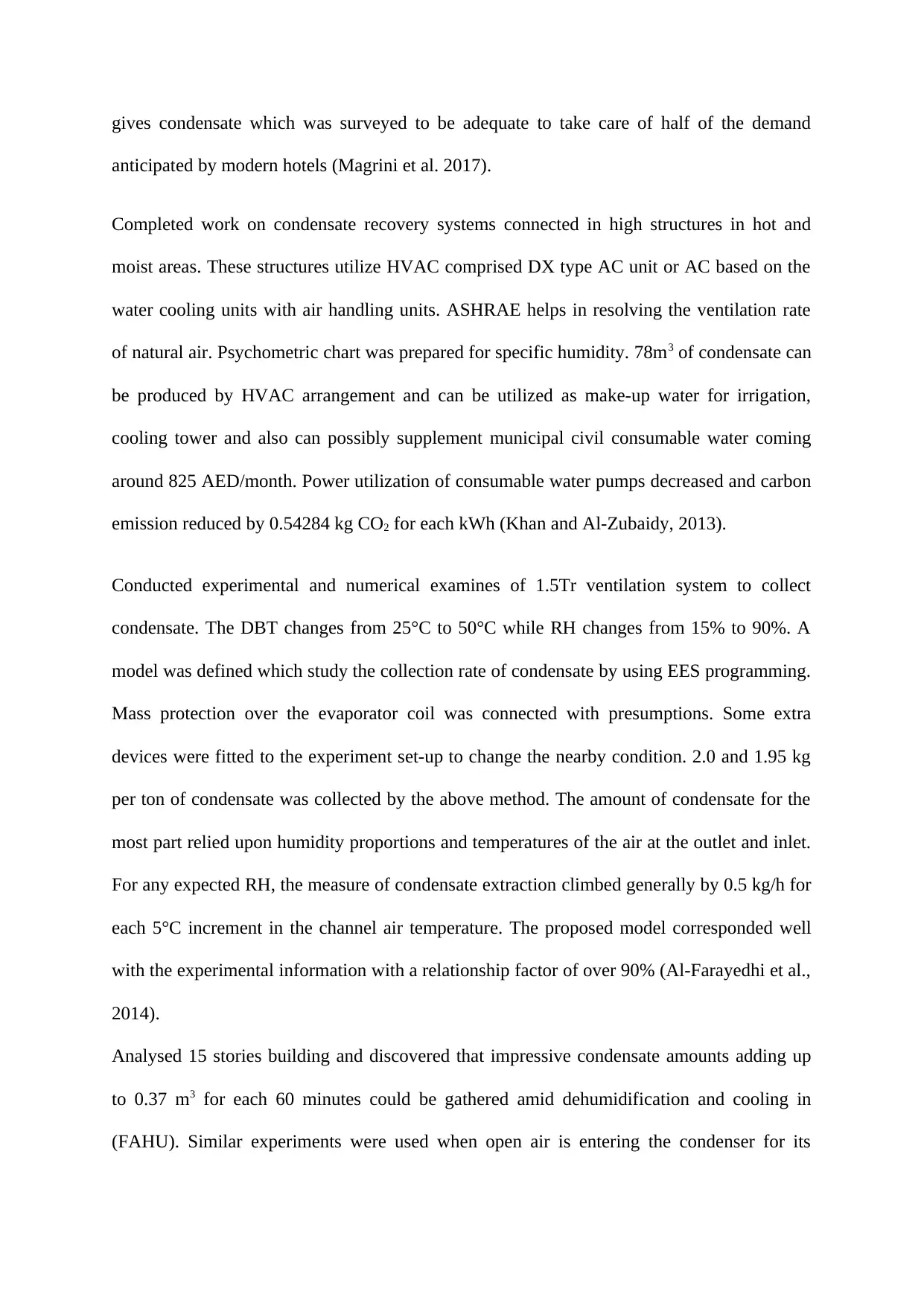
gives condensate which was surveyed to be adequate to take care of half of the demand
anticipated by modern hotels (Magrini et al. 2017).
Completed work on condensate recovery systems connected in high structures in hot and
moist areas. These structures utilize HVAC comprised DX type AC unit or AC based on the
water cooling units with air handling units. ASHRAE helps in resolving the ventilation rate
of natural air. Psychometric chart was prepared for specific humidity. 78m3 of condensate can
be produced by HVAC arrangement and can be utilized as make-up water for irrigation,
cooling tower and also can possibly supplement municipal civil consumable water coming
around 825 AED/month. Power utilization of consumable water pumps decreased and carbon
emission reduced by 0.54284 kg CO2 for each kWh (Khan and Al-Zubaidy, 2013).
Conducted experimental and numerical examines of 1.5Tr ventilation system to collect
condensate. The DBT changes from 25°C to 50°C while RH changes from 15% to 90%. A
model was defined which study the collection rate of condensate by using EES programming.
Mass protection over the evaporator coil was connected with presumptions. Some extra
devices were fitted to the experiment set-up to change the nearby condition. 2.0 and 1.95 kg
per ton of condensate was collected by the above method. The amount of condensate for the
most part relied upon humidity proportions and temperatures of the air at the outlet and inlet.
For any expected RH, the measure of condensate extraction climbed generally by 0.5 kg/h for
each 5°C increment in the channel air temperature. The proposed model corresponded well
with the experimental information with a relationship factor of over 90% (Al-Farayedhi et al.,
2014).
Analysed 15 stories building and discovered that impressive condensate amounts adding up
to 0.37 m3 for each 60 minutes could be gathered amid dehumidification and cooling in
(FAHU). Similar experiments were used when open air is entering the condenser for its
anticipated by modern hotels (Magrini et al. 2017).
Completed work on condensate recovery systems connected in high structures in hot and
moist areas. These structures utilize HVAC comprised DX type AC unit or AC based on the
water cooling units with air handling units. ASHRAE helps in resolving the ventilation rate
of natural air. Psychometric chart was prepared for specific humidity. 78m3 of condensate can
be produced by HVAC arrangement and can be utilized as make-up water for irrigation,
cooling tower and also can possibly supplement municipal civil consumable water coming
around 825 AED/month. Power utilization of consumable water pumps decreased and carbon
emission reduced by 0.54284 kg CO2 for each kWh (Khan and Al-Zubaidy, 2013).
Conducted experimental and numerical examines of 1.5Tr ventilation system to collect
condensate. The DBT changes from 25°C to 50°C while RH changes from 15% to 90%. A
model was defined which study the collection rate of condensate by using EES programming.
Mass protection over the evaporator coil was connected with presumptions. Some extra
devices were fitted to the experiment set-up to change the nearby condition. 2.0 and 1.95 kg
per ton of condensate was collected by the above method. The amount of condensate for the
most part relied upon humidity proportions and temperatures of the air at the outlet and inlet.
For any expected RH, the measure of condensate extraction climbed generally by 0.5 kg/h for
each 5°C increment in the channel air temperature. The proposed model corresponded well
with the experimental information with a relationship factor of over 90% (Al-Farayedhi et al.,
2014).
Analysed 15 stories building and discovered that impressive condensate amounts adding up
to 0.37 m3 for each 60 minutes could be gathered amid dehumidification and cooling in
(FAHU). Similar experiments were used when open air is entering the condenser for its
Paraphrase This Document
Need a fresh take? Get an instant paraphrase of this document with our AI Paraphraser
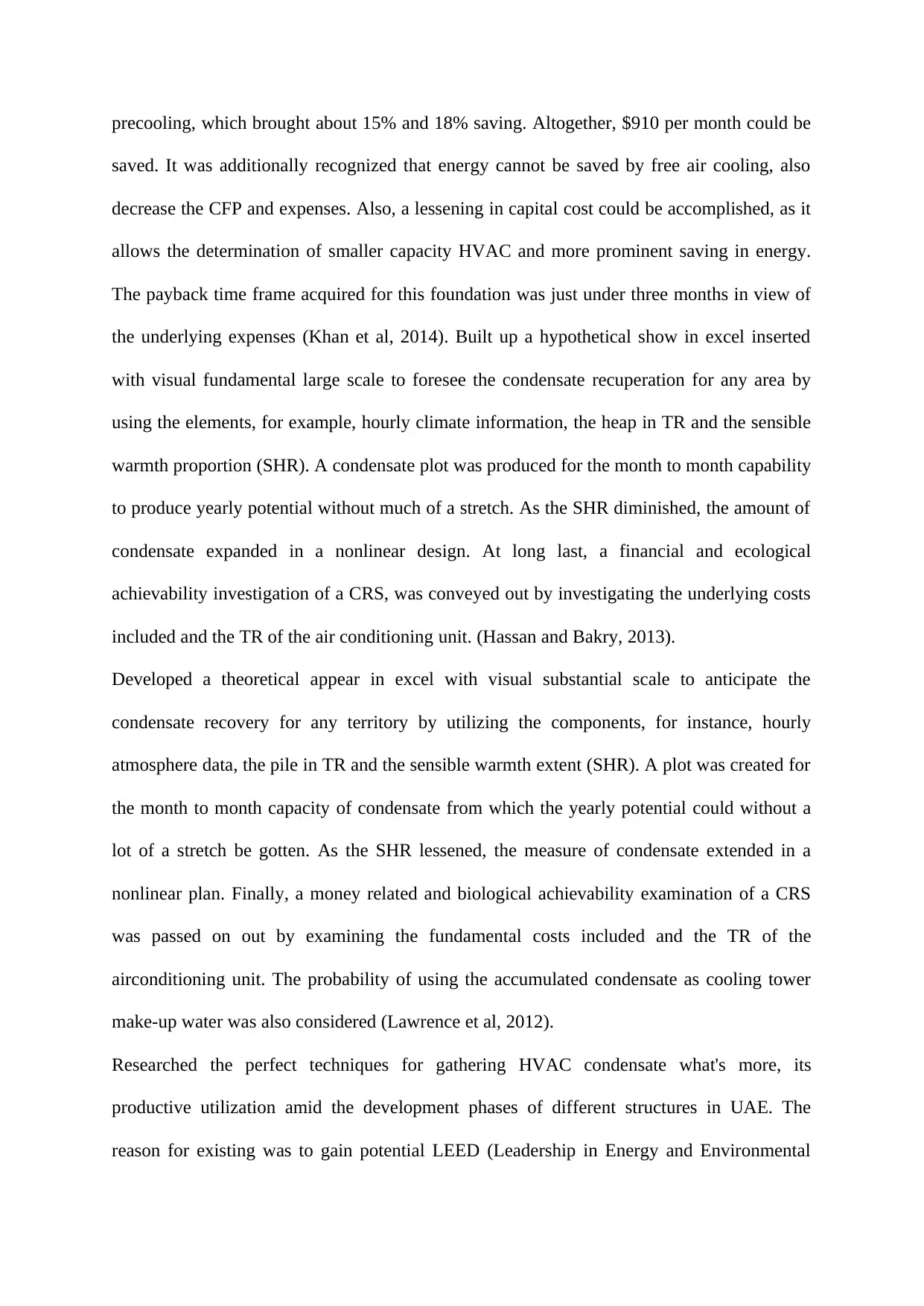
precooling, which brought about 15% and 18% saving. Altogether, $910 per month could be
saved. It was additionally recognized that energy cannot be saved by free air cooling, also
decrease the CFP and expenses. Also, a lessening in capital cost could be accomplished, as it
allows the determination of smaller capacity HVAC and more prominent saving in energy.
The payback time frame acquired for this foundation was just under three months in view of
the underlying expenses (Khan et al, 2014). Built up a hypothetical show in excel inserted
with visual fundamental large scale to foresee the condensate recuperation for any area by
using the elements, for example, hourly climate information, the heap in TR and the sensible
warmth proportion (SHR). A condensate plot was produced for the month to month capability
to produce yearly potential without much of a stretch. As the SHR diminished, the amount of
condensate expanded in a nonlinear design. At long last, a financial and ecological
achievability investigation of a CRS, was conveyed out by investigating the underlying costs
included and the TR of the air conditioning unit. (Hassan and Bakry, 2013).
Developed a theoretical appear in excel with visual substantial scale to anticipate the
condensate recovery for any territory by utilizing the components, for instance, hourly
atmosphere data, the pile in TR and the sensible warmth extent (SHR). A plot was created for
the month to month capacity of condensate from which the yearly potential could without a
lot of a stretch be gotten. As the SHR lessened, the measure of condensate extended in a
nonlinear plan. Finally, a money related and biological achievability examination of a CRS
was passed on out by examining the fundamental costs included and the TR of the
airconditioning unit. The probability of using the accumulated condensate as cooling tower
make-up water was also considered (Lawrence et al, 2012).
Researched the perfect techniques for gathering HVAC condensate what's more, its
productive utilization amid the development phases of different structures in UAE. The
reason for existing was to gain potential LEED (Leadership in Energy and Environmental
saved. It was additionally recognized that energy cannot be saved by free air cooling, also
decrease the CFP and expenses. Also, a lessening in capital cost could be accomplished, as it
allows the determination of smaller capacity HVAC and more prominent saving in energy.
The payback time frame acquired for this foundation was just under three months in view of
the underlying expenses (Khan et al, 2014). Built up a hypothetical show in excel inserted
with visual fundamental large scale to foresee the condensate recuperation for any area by
using the elements, for example, hourly climate information, the heap in TR and the sensible
warmth proportion (SHR). A condensate plot was produced for the month to month capability
to produce yearly potential without much of a stretch. As the SHR diminished, the amount of
condensate expanded in a nonlinear design. At long last, a financial and ecological
achievability investigation of a CRS, was conveyed out by investigating the underlying costs
included and the TR of the air conditioning unit. (Hassan and Bakry, 2013).
Developed a theoretical appear in excel with visual substantial scale to anticipate the
condensate recovery for any territory by utilizing the components, for instance, hourly
atmosphere data, the pile in TR and the sensible warmth extent (SHR). A plot was created for
the month to month capacity of condensate from which the yearly potential could without a
lot of a stretch be gotten. As the SHR lessened, the measure of condensate extended in a
nonlinear plan. Finally, a money related and biological achievability examination of a CRS
was passed on out by examining the fundamental costs included and the TR of the
airconditioning unit. The probability of using the accumulated condensate as cooling tower
make-up water was also considered (Lawrence et al, 2012).
Researched the perfect techniques for gathering HVAC condensate what's more, its
productive utilization amid the development phases of different structures in UAE. The
reason for existing was to gain potential LEED (Leadership in Energy and Environmental
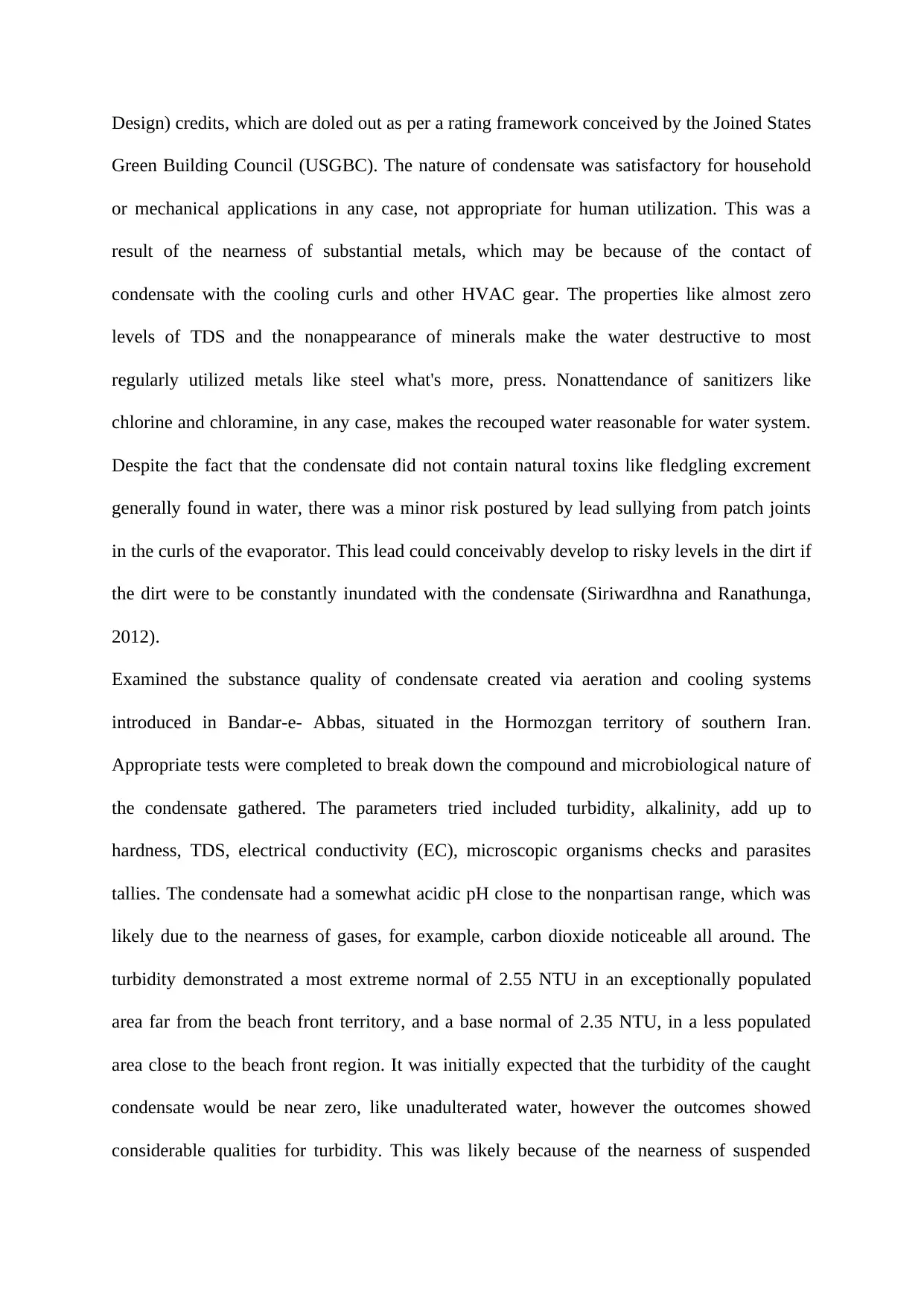
Design) credits, which are doled out as per a rating framework conceived by the Joined States
Green Building Council (USGBC). The nature of condensate was satisfactory for household
or mechanical applications in any case, not appropriate for human utilization. This was a
result of the nearness of substantial metals, which may be because of the contact of
condensate with the cooling curls and other HVAC gear. The properties like almost zero
levels of TDS and the nonappearance of minerals make the water destructive to most
regularly utilized metals like steel what's more, press. Nonattendance of sanitizers like
chlorine and chloramine, in any case, makes the recouped water reasonable for water system.
Despite the fact that the condensate did not contain natural toxins like fledgling excrement
generally found in water, there was a minor risk postured by lead sullying from patch joints
in the curls of the evaporator. This lead could conceivably develop to risky levels in the dirt if
the dirt were to be constantly inundated with the condensate (Siriwardhna and Ranathunga,
2012).
Examined the substance quality of condensate created via aeration and cooling systems
introduced in Bandar-e- Abbas, situated in the Hormozgan territory of southern Iran.
Appropriate tests were completed to break down the compound and microbiological nature of
the condensate gathered. The parameters tried included turbidity, alkalinity, add up to
hardness, TDS, electrical conductivity (EC), microscopic organisms checks and parasites
tallies. The condensate had a somewhat acidic pH close to the nonpartisan range, which was
likely due to the nearness of gases, for example, carbon dioxide noticeable all around. The
turbidity demonstrated a most extreme normal of 2.55 NTU in an exceptionally populated
area far from the beach front territory, and a base normal of 2.35 NTU, in a less populated
area close to the beach front region. It was initially expected that the turbidity of the caught
condensate would be near zero, like unadulterated water, however the outcomes showed
considerable qualities for turbidity. This was likely because of the nearness of suspended
Green Building Council (USGBC). The nature of condensate was satisfactory for household
or mechanical applications in any case, not appropriate for human utilization. This was a
result of the nearness of substantial metals, which may be because of the contact of
condensate with the cooling curls and other HVAC gear. The properties like almost zero
levels of TDS and the nonappearance of minerals make the water destructive to most
regularly utilized metals like steel what's more, press. Nonattendance of sanitizers like
chlorine and chloramine, in any case, makes the recouped water reasonable for water system.
Despite the fact that the condensate did not contain natural toxins like fledgling excrement
generally found in water, there was a minor risk postured by lead sullying from patch joints
in the curls of the evaporator. This lead could conceivably develop to risky levels in the dirt if
the dirt were to be constantly inundated with the condensate (Siriwardhna and Ranathunga,
2012).
Examined the substance quality of condensate created via aeration and cooling systems
introduced in Bandar-e- Abbas, situated in the Hormozgan territory of southern Iran.
Appropriate tests were completed to break down the compound and microbiological nature of
the condensate gathered. The parameters tried included turbidity, alkalinity, add up to
hardness, TDS, electrical conductivity (EC), microscopic organisms checks and parasites
tallies. The condensate had a somewhat acidic pH close to the nonpartisan range, which was
likely due to the nearness of gases, for example, carbon dioxide noticeable all around. The
turbidity demonstrated a most extreme normal of 2.55 NTU in an exceptionally populated
area far from the beach front territory, and a base normal of 2.35 NTU, in a less populated
area close to the beach front region. It was initially expected that the turbidity of the caught
condensate would be near zero, like unadulterated water, however the outcomes showed
considerable qualities for turbidity. This was likely because of the nearness of suspended
⊘ This is a preview!⊘
Do you want full access?
Subscribe today to unlock all pages.

Trusted by 1+ million students worldwide
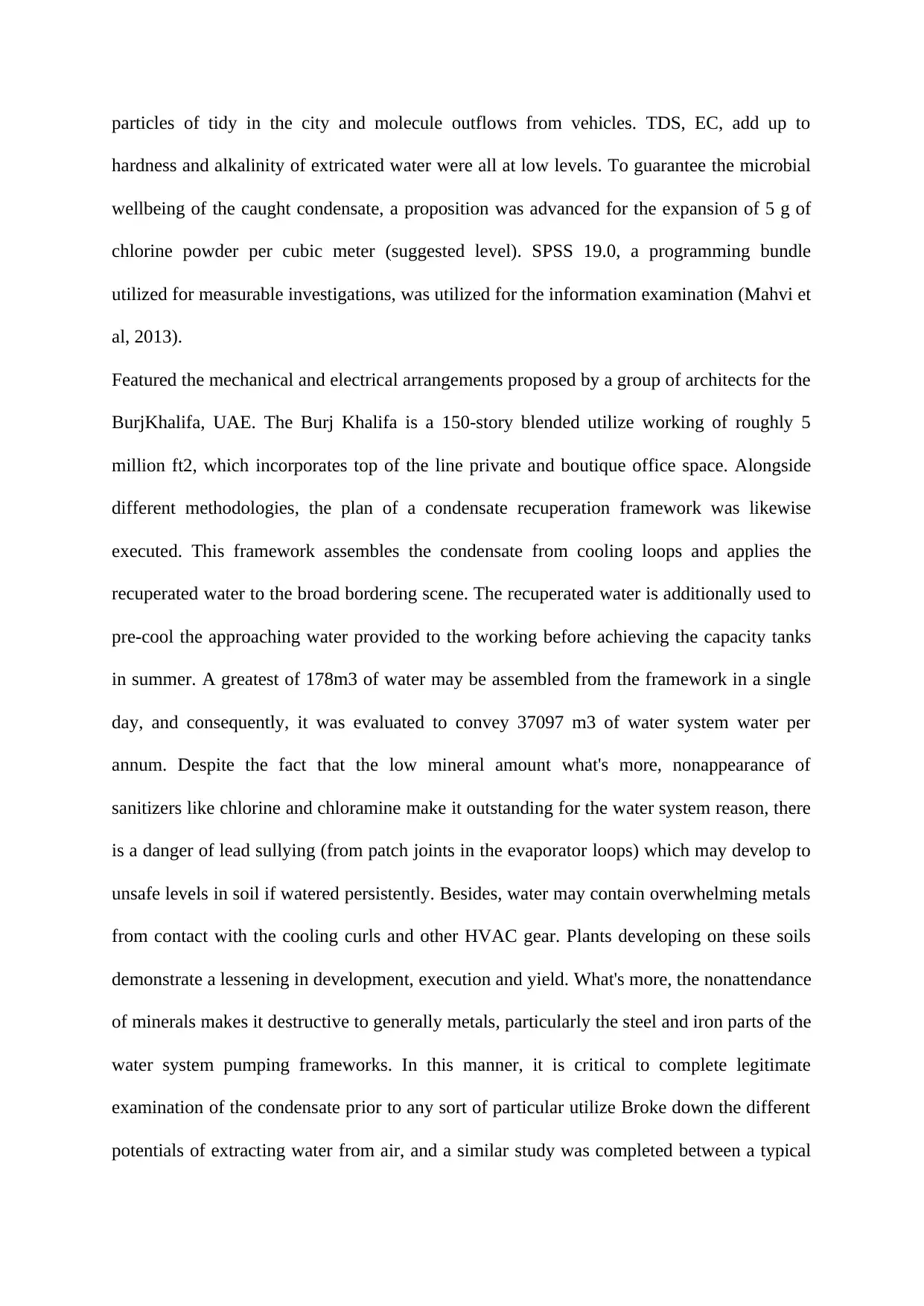
particles of tidy in the city and molecule outflows from vehicles. TDS, EC, add up to
hardness and alkalinity of extricated water were all at low levels. To guarantee the microbial
wellbeing of the caught condensate, a proposition was advanced for the expansion of 5 g of
chlorine powder per cubic meter (suggested level). SPSS 19.0, a programming bundle
utilized for measurable investigations, was utilized for the information examination (Mahvi et
al, 2013).
Featured the mechanical and electrical arrangements proposed by a group of architects for the
BurjKhalifa, UAE. The Burj Khalifa is a 150-story blended utilize working of roughly 5
million ft2, which incorporates top of the line private and boutique office space. Alongside
different methodologies, the plan of a condensate recuperation framework was likewise
executed. This framework assembles the condensate from cooling loops and applies the
recuperated water to the broad bordering scene. The recuperated water is additionally used to
pre-cool the approaching water provided to the working before achieving the capacity tanks
in summer. A greatest of 178m3 of water may be assembled from the framework in a single
day, and consequently, it was evaluated to convey 37097 m3 of water system water per
annum. Despite the fact that the low mineral amount what's more, nonappearance of
sanitizers like chlorine and chloramine make it outstanding for the water system reason, there
is a danger of lead sullying (from patch joints in the evaporator loops) which may develop to
unsafe levels in soil if watered persistently. Besides, water may contain overwhelming metals
from contact with the cooling curls and other HVAC gear. Plants developing on these soils
demonstrate a lessening in development, execution and yield. What's more, the nonattendance
of minerals makes it destructive to generally metals, particularly the steel and iron parts of the
water system pumping frameworks. In this manner, it is critical to complete legitimate
examination of the condensate prior to any sort of particular utilize Broke down the different
potentials of extracting water from air, and a similar study was completed between a typical
hardness and alkalinity of extricated water were all at low levels. To guarantee the microbial
wellbeing of the caught condensate, a proposition was advanced for the expansion of 5 g of
chlorine powder per cubic meter (suggested level). SPSS 19.0, a programming bundle
utilized for measurable investigations, was utilized for the information examination (Mahvi et
al, 2013).
Featured the mechanical and electrical arrangements proposed by a group of architects for the
BurjKhalifa, UAE. The Burj Khalifa is a 150-story blended utilize working of roughly 5
million ft2, which incorporates top of the line private and boutique office space. Alongside
different methodologies, the plan of a condensate recuperation framework was likewise
executed. This framework assembles the condensate from cooling loops and applies the
recuperated water to the broad bordering scene. The recuperated water is additionally used to
pre-cool the approaching water provided to the working before achieving the capacity tanks
in summer. A greatest of 178m3 of water may be assembled from the framework in a single
day, and consequently, it was evaluated to convey 37097 m3 of water system water per
annum. Despite the fact that the low mineral amount what's more, nonappearance of
sanitizers like chlorine and chloramine make it outstanding for the water system reason, there
is a danger of lead sullying (from patch joints in the evaporator loops) which may develop to
unsafe levels in soil if watered persistently. Besides, water may contain overwhelming metals
from contact with the cooling curls and other HVAC gear. Plants developing on these soils
demonstrate a lessening in development, execution and yield. What's more, the nonattendance
of minerals makes it destructive to generally metals, particularly the steel and iron parts of the
water system pumping frameworks. In this manner, it is critical to complete legitimate
examination of the condensate prior to any sort of particular utilize Broke down the different
potentials of extracting water from air, and a similar study was completed between a typical
Paraphrase This Document
Need a fresh take? Get an instant paraphrase of this document with our AI Paraphraser

HVAC system and an integrated HVAC system set up. Despite the fact that the condensate
created by the run of the HVAC system was generous, it was normally unused because of the
absence of applications. The integrated HVAC system was intended for double purposes, to
be specific, water production also, air conditioning, and thus, the system guarantees
investment funds regarding both energy and water. This condensate made up for 56.4% of the
everyday water and reduced the general cost of water by 19%. Additionally, the investment
acquired from this arrangement could remunerate the additional cost of the coordinated Air
conditioning system. Further, if any water treatment is requested at the rate of 1.14 AED/m3
(where AED refers to United Arab Emirates Dirham), the general cost diminish for
consumable water becomes 7%.
Explored the techniques for gathering HVAC condensate and its utilization amid the
development phases of different buildings. The reason for this was to obtain potential LEED
(Leadership in Energy and Environmental Design) credits, which are assigned as indicated by
a rating system by the Joined States Green Building Council (USGBC). The nature of
condensate was satisfactory industries and domestic buildings, but was not reasonable for
human utilization. This was a result of the nearness of metals, which may be because of the
contact of condensate with the cooling coils and other HVAC machines. The properties like
zero levels TDS and the nonappearance of minerals make the water destructive to most
regularly utilized metals like steel and iron etc. Nonattendance of sanitizers like chlorine and
chloramine, makes the water appropriate for irrigation. Despite the fact that the condensate
did not contain natural toxins like flying creature dung generally found in water, there was a
minor risk postured by lead pollution from weld joints in the coils of evaporator. This lead
could possibly develop dangerous chemicals in the soil if the soil was continuously watered
with the condensate.
created by the run of the HVAC system was generous, it was normally unused because of the
absence of applications. The integrated HVAC system was intended for double purposes, to
be specific, water production also, air conditioning, and thus, the system guarantees
investment funds regarding both energy and water. This condensate made up for 56.4% of the
everyday water and reduced the general cost of water by 19%. Additionally, the investment
acquired from this arrangement could remunerate the additional cost of the coordinated Air
conditioning system. Further, if any water treatment is requested at the rate of 1.14 AED/m3
(where AED refers to United Arab Emirates Dirham), the general cost diminish for
consumable water becomes 7%.
Explored the techniques for gathering HVAC condensate and its utilization amid the
development phases of different buildings. The reason for this was to obtain potential LEED
(Leadership in Energy and Environmental Design) credits, which are assigned as indicated by
a rating system by the Joined States Green Building Council (USGBC). The nature of
condensate was satisfactory industries and domestic buildings, but was not reasonable for
human utilization. This was a result of the nearness of metals, which may be because of the
contact of condensate with the cooling coils and other HVAC machines. The properties like
zero levels TDS and the nonappearance of minerals make the water destructive to most
regularly utilized metals like steel and iron etc. Nonattendance of sanitizers like chlorine and
chloramine, makes the water appropriate for irrigation. Despite the fact that the condensate
did not contain natural toxins like flying creature dung generally found in water, there was a
minor risk postured by lead pollution from weld joints in the coils of evaporator. This lead
could possibly develop dangerous chemicals in the soil if the soil was continuously watered
with the condensate.
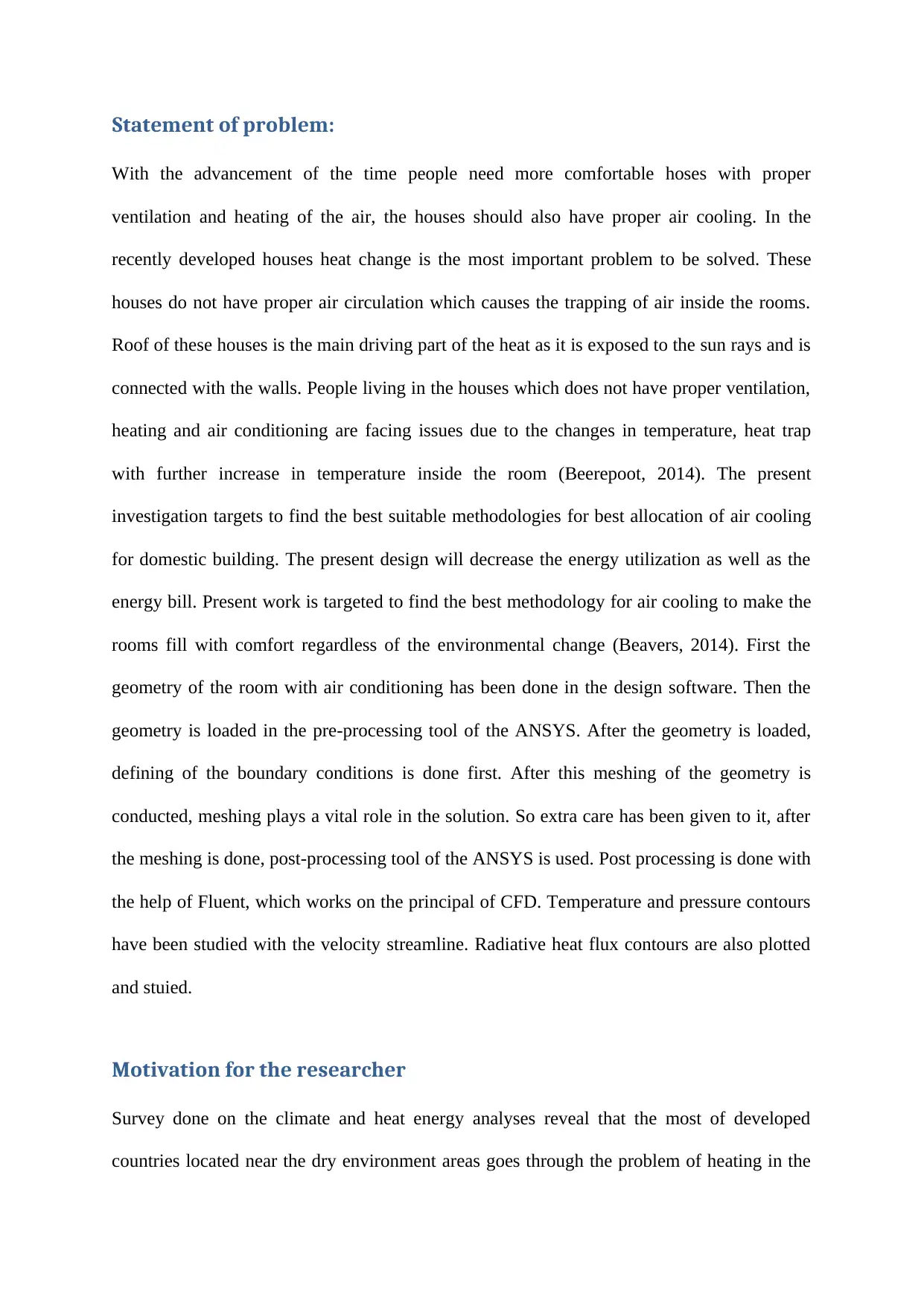
Statement of problem:
With the advancement of the time people need more comfortable hoses with proper
ventilation and heating of the air, the houses should also have proper air cooling. In the
recently developed houses heat change is the most important problem to be solved. These
houses do not have proper air circulation which causes the trapping of air inside the rooms.
Roof of these houses is the main driving part of the heat as it is exposed to the sun rays and is
connected with the walls. People living in the houses which does not have proper ventilation,
heating and air conditioning are facing issues due to the changes in temperature, heat trap
with further increase in temperature inside the room (Beerepoot, 2014). The present
investigation targets to find the best suitable methodologies for best allocation of air cooling
for domestic building. The present design will decrease the energy utilization as well as the
energy bill. Present work is targeted to find the best methodology for air cooling to make the
rooms fill with comfort regardless of the environmental change (Beavers, 2014). First the
geometry of the room with air conditioning has been done in the design software. Then the
geometry is loaded in the pre-processing tool of the ANSYS. After the geometry is loaded,
defining of the boundary conditions is done first. After this meshing of the geometry is
conducted, meshing plays a vital role in the solution. So extra care has been given to it, after
the meshing is done, post-processing tool of the ANSYS is used. Post processing is done with
the help of Fluent, which works on the principal of CFD. Temperature and pressure contours
have been studied with the velocity streamline. Radiative heat flux contours are also plotted
and stuied.
Motivation for the researcher
Survey done on the climate and heat energy analyses reveal that the most of developed
countries located near the dry environment areas goes through the problem of heating in the
With the advancement of the time people need more comfortable hoses with proper
ventilation and heating of the air, the houses should also have proper air cooling. In the
recently developed houses heat change is the most important problem to be solved. These
houses do not have proper air circulation which causes the trapping of air inside the rooms.
Roof of these houses is the main driving part of the heat as it is exposed to the sun rays and is
connected with the walls. People living in the houses which does not have proper ventilation,
heating and air conditioning are facing issues due to the changes in temperature, heat trap
with further increase in temperature inside the room (Beerepoot, 2014). The present
investigation targets to find the best suitable methodologies for best allocation of air cooling
for domestic building. The present design will decrease the energy utilization as well as the
energy bill. Present work is targeted to find the best methodology for air cooling to make the
rooms fill with comfort regardless of the environmental change (Beavers, 2014). First the
geometry of the room with air conditioning has been done in the design software. Then the
geometry is loaded in the pre-processing tool of the ANSYS. After the geometry is loaded,
defining of the boundary conditions is done first. After this meshing of the geometry is
conducted, meshing plays a vital role in the solution. So extra care has been given to it, after
the meshing is done, post-processing tool of the ANSYS is used. Post processing is done with
the help of Fluent, which works on the principal of CFD. Temperature and pressure contours
have been studied with the velocity streamline. Radiative heat flux contours are also plotted
and stuied.
Motivation for the researcher
Survey done on the climate and heat energy analyses reveal that the most of developed
countries located near the dry environment areas goes through the problem of heating in the
⊘ This is a preview!⊘
Do you want full access?
Subscribe today to unlock all pages.

Trusted by 1+ million students worldwide
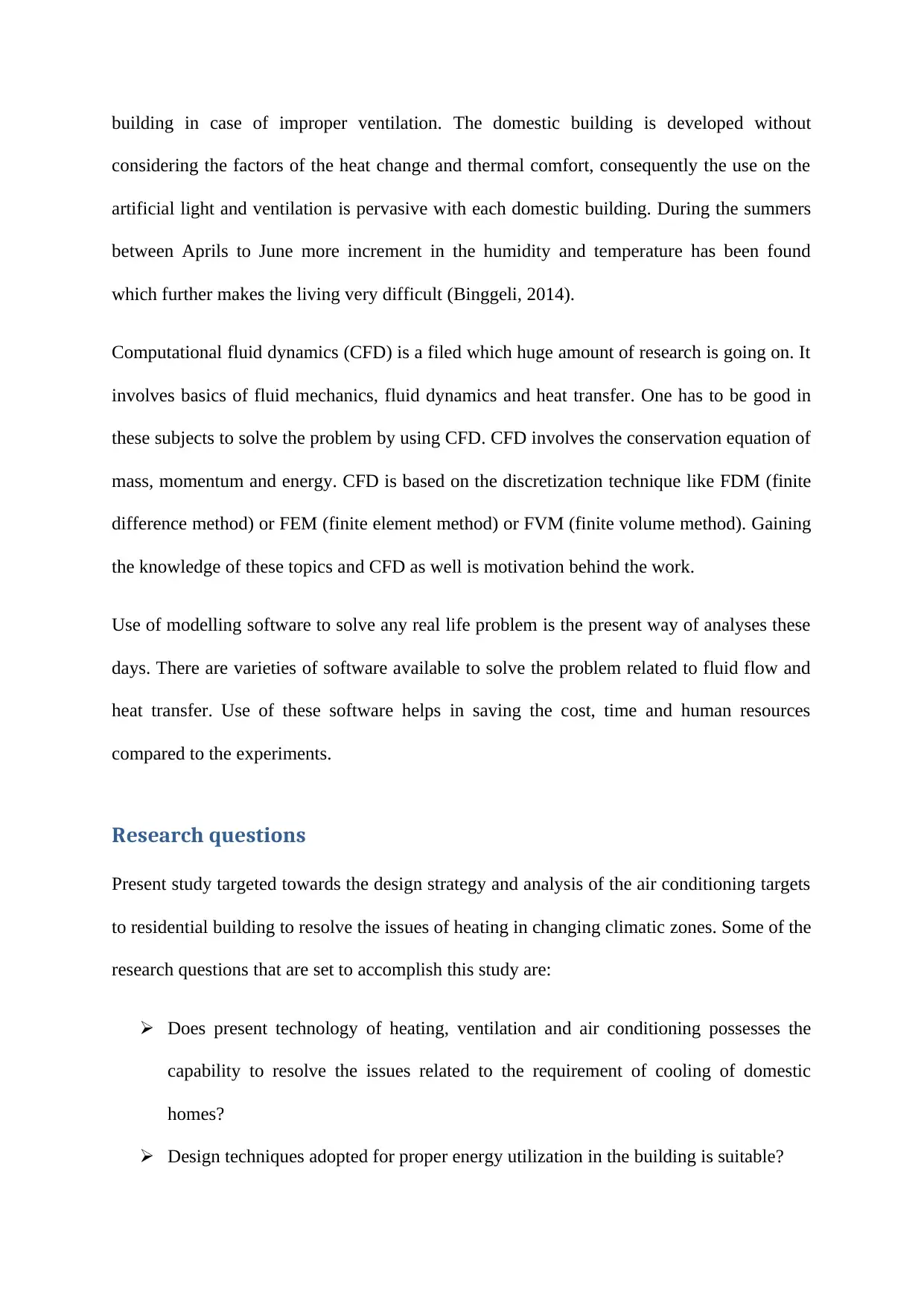
building in case of improper ventilation. The domestic building is developed without
considering the factors of the heat change and thermal comfort, consequently the use on the
artificial light and ventilation is pervasive with each domestic building. During the summers
between Aprils to June more increment in the humidity and temperature has been found
which further makes the living very difficult (Binggeli, 2014).
Computational fluid dynamics (CFD) is a filed which huge amount of research is going on. It
involves basics of fluid mechanics, fluid dynamics and heat transfer. One has to be good in
these subjects to solve the problem by using CFD. CFD involves the conservation equation of
mass, momentum and energy. CFD is based on the discretization technique like FDM (finite
difference method) or FEM (finite element method) or FVM (finite volume method). Gaining
the knowledge of these topics and CFD as well is motivation behind the work.
Use of modelling software to solve any real life problem is the present way of analyses these
days. There are varieties of software available to solve the problem related to fluid flow and
heat transfer. Use of these software helps in saving the cost, time and human resources
compared to the experiments.
Research questions
Present study targeted towards the design strategy and analysis of the air conditioning targets
to residential building to resolve the issues of heating in changing climatic zones. Some of the
research questions that are set to accomplish this study are:
Does present technology of heating, ventilation and air conditioning possesses the
capability to resolve the issues related to the requirement of cooling of domestic
homes?
Design techniques adopted for proper energy utilization in the building is suitable?
considering the factors of the heat change and thermal comfort, consequently the use on the
artificial light and ventilation is pervasive with each domestic building. During the summers
between Aprils to June more increment in the humidity and temperature has been found
which further makes the living very difficult (Binggeli, 2014).
Computational fluid dynamics (CFD) is a filed which huge amount of research is going on. It
involves basics of fluid mechanics, fluid dynamics and heat transfer. One has to be good in
these subjects to solve the problem by using CFD. CFD involves the conservation equation of
mass, momentum and energy. CFD is based on the discretization technique like FDM (finite
difference method) or FEM (finite element method) or FVM (finite volume method). Gaining
the knowledge of these topics and CFD as well is motivation behind the work.
Use of modelling software to solve any real life problem is the present way of analyses these
days. There are varieties of software available to solve the problem related to fluid flow and
heat transfer. Use of these software helps in saving the cost, time and human resources
compared to the experiments.
Research questions
Present study targeted towards the design strategy and analysis of the air conditioning targets
to residential building to resolve the issues of heating in changing climatic zones. Some of the
research questions that are set to accomplish this study are:
Does present technology of heating, ventilation and air conditioning possesses the
capability to resolve the issues related to the requirement of cooling of domestic
homes?
Design techniques adopted for proper energy utilization in the building is suitable?
Paraphrase This Document
Need a fresh take? Get an instant paraphrase of this document with our AI Paraphraser
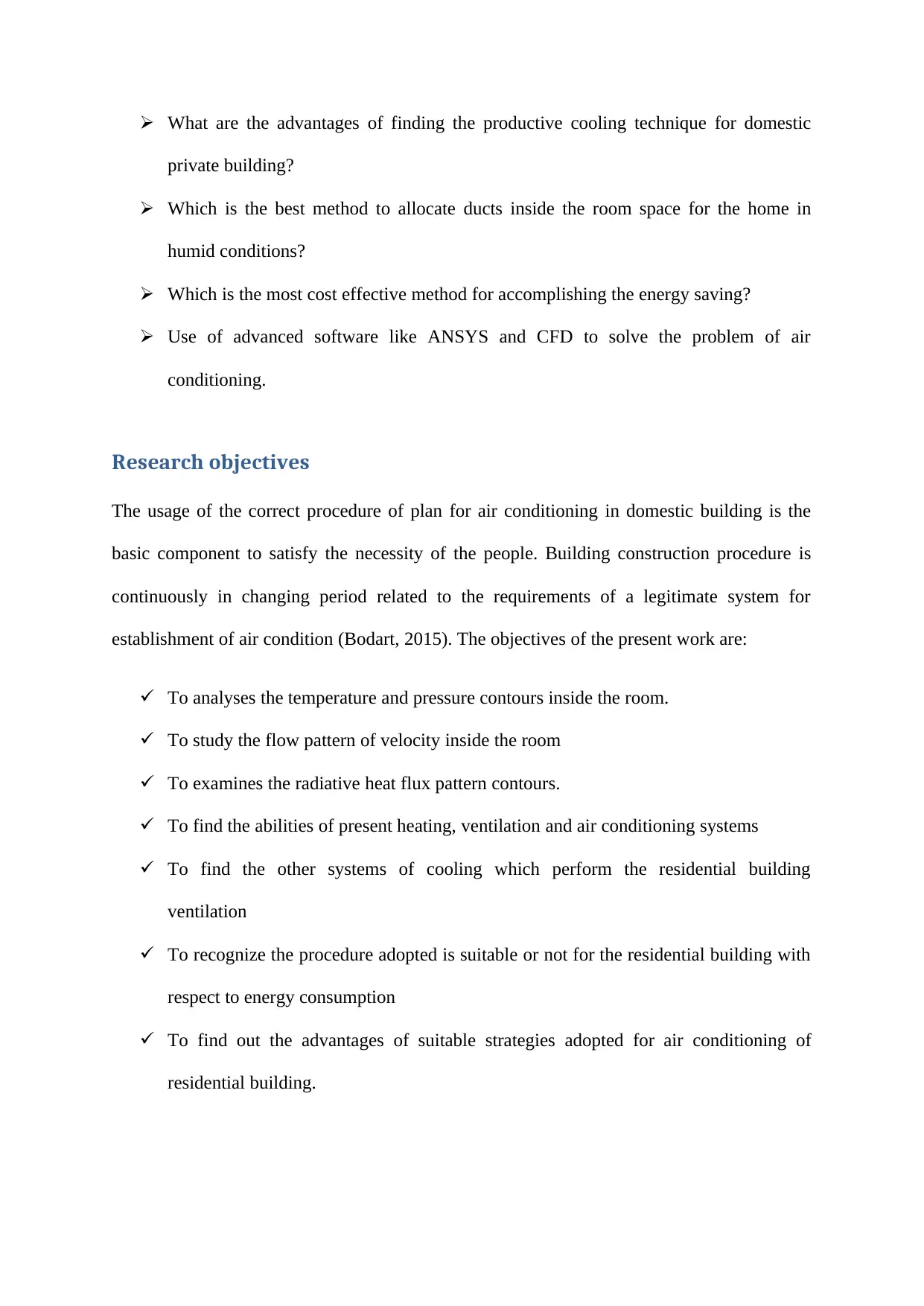
What are the advantages of finding the productive cooling technique for domestic
private building?
Which is the best method to allocate ducts inside the room space for the home in
humid conditions?
Which is the most cost effective method for accomplishing the energy saving?
Use of advanced software like ANSYS and CFD to solve the problem of air
conditioning.
Research objectives
The usage of the correct procedure of plan for air conditioning in domestic building is the
basic component to satisfy the necessity of the people. Building construction procedure is
continuously in changing period related to the requirements of a legitimate system for
establishment of air condition (Bodart, 2015). The objectives of the present work are:
To analyses the temperature and pressure contours inside the room.
To study the flow pattern of velocity inside the room
To examines the radiative heat flux pattern contours.
To find the abilities of present heating, ventilation and air conditioning systems
To find the other systems of cooling which perform the residential building
ventilation
To recognize the procedure adopted is suitable or not for the residential building with
respect to energy consumption
To find out the advantages of suitable strategies adopted for air conditioning of
residential building.
private building?
Which is the best method to allocate ducts inside the room space for the home in
humid conditions?
Which is the most cost effective method for accomplishing the energy saving?
Use of advanced software like ANSYS and CFD to solve the problem of air
conditioning.
Research objectives
The usage of the correct procedure of plan for air conditioning in domestic building is the
basic component to satisfy the necessity of the people. Building construction procedure is
continuously in changing period related to the requirements of a legitimate system for
establishment of air condition (Bodart, 2015). The objectives of the present work are:
To analyses the temperature and pressure contours inside the room.
To study the flow pattern of velocity inside the room
To examines the radiative heat flux pattern contours.
To find the abilities of present heating, ventilation and air conditioning systems
To find the other systems of cooling which perform the residential building
ventilation
To recognize the procedure adopted is suitable or not for the residential building with
respect to energy consumption
To find out the advantages of suitable strategies adopted for air conditioning of
residential building.
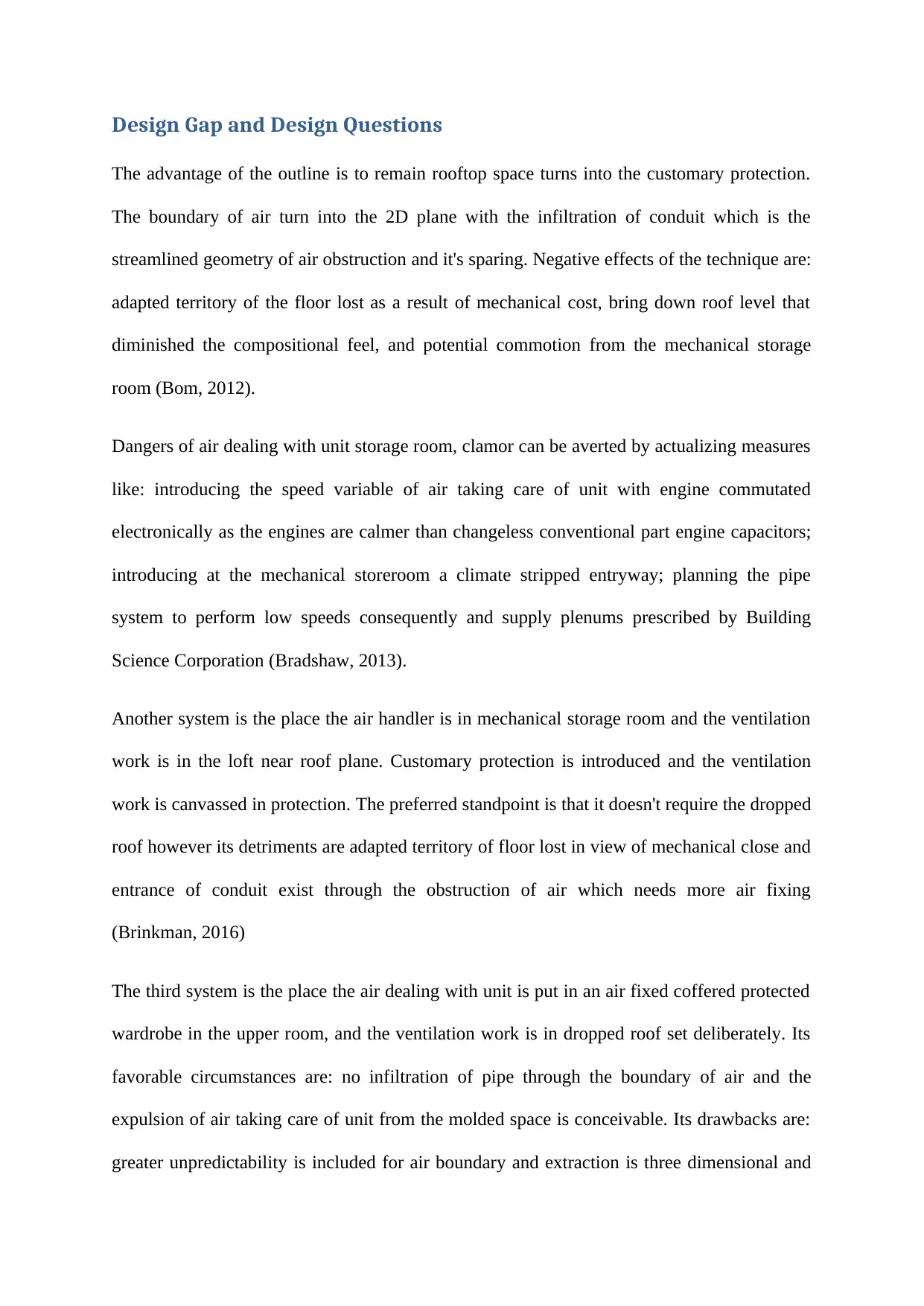
Design Gap and Design Questions
The advantage of the outline is to remain rooftop space turns into the customary protection.
The boundary of air turn into the 2D plane with the infiltration of conduit which is the
streamlined geometry of air obstruction and it's sparing. Negative effects of the technique are:
adapted territory of the floor lost as a result of mechanical cost, bring down roof level that
diminished the compositional feel, and potential commotion from the mechanical storage
room (Bom, 2012).
Dangers of air dealing with unit storage room, clamor can be averted by actualizing measures
like: introducing the speed variable of air taking care of unit with engine commutated
electronically as the engines are calmer than changeless conventional part engine capacitors;
introducing at the mechanical storeroom a climate stripped entryway; planning the pipe
system to perform low speeds consequently and supply plenums prescribed by Building
Science Corporation (Bradshaw, 2013).
Another system is the place the air handler is in mechanical storage room and the ventilation
work is in the loft near roof plane. Customary protection is introduced and the ventilation
work is canvassed in protection. The preferred standpoint is that it doesn't require the dropped
roof however its detriments are adapted territory of floor lost in view of mechanical close and
entrance of conduit exist through the obstruction of air which needs more air fixing
(Brinkman, 2016)
The third system is the place the air dealing with unit is put in an air fixed coffered protected
wardrobe in the upper room, and the ventilation work is in dropped roof set deliberately. Its
favorable circumstances are: no infiltration of pipe through the boundary of air and the
expulsion of air taking care of unit from the molded space is conceivable. Its drawbacks are:
greater unpredictability is included for air boundary and extraction is three dimensional and
The advantage of the outline is to remain rooftop space turns into the customary protection.
The boundary of air turn into the 2D plane with the infiltration of conduit which is the
streamlined geometry of air obstruction and it's sparing. Negative effects of the technique are:
adapted territory of the floor lost as a result of mechanical cost, bring down roof level that
diminished the compositional feel, and potential commotion from the mechanical storage
room (Bom, 2012).
Dangers of air dealing with unit storage room, clamor can be averted by actualizing measures
like: introducing the speed variable of air taking care of unit with engine commutated
electronically as the engines are calmer than changeless conventional part engine capacitors;
introducing at the mechanical storeroom a climate stripped entryway; planning the pipe
system to perform low speeds consequently and supply plenums prescribed by Building
Science Corporation (Bradshaw, 2013).
Another system is the place the air handler is in mechanical storage room and the ventilation
work is in the loft near roof plane. Customary protection is introduced and the ventilation
work is canvassed in protection. The preferred standpoint is that it doesn't require the dropped
roof however its detriments are adapted territory of floor lost in view of mechanical close and
entrance of conduit exist through the obstruction of air which needs more air fixing
(Brinkman, 2016)
The third system is the place the air dealing with unit is put in an air fixed coffered protected
wardrobe in the upper room, and the ventilation work is in dropped roof set deliberately. Its
favorable circumstances are: no infiltration of pipe through the boundary of air and the
expulsion of air taking care of unit from the molded space is conceivable. Its drawbacks are:
greater unpredictability is included for air boundary and extraction is three dimensional and
⊘ This is a preview!⊘
Do you want full access?
Subscribe today to unlock all pages.

Trusted by 1+ million students worldwide
1 out of 38
Your All-in-One AI-Powered Toolkit for Academic Success.
+13062052269
info@desklib.com
Available 24*7 on WhatsApp / Email
![[object Object]](/_next/static/media/star-bottom.7253800d.svg)
Unlock your academic potential
Copyright © 2020–2025 A2Z Services. All Rights Reserved. Developed and managed by ZUCOL.


